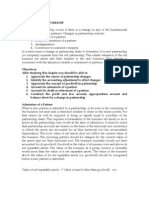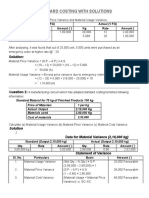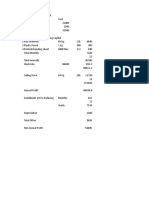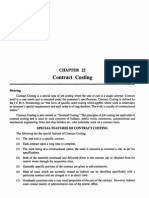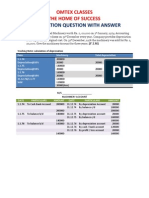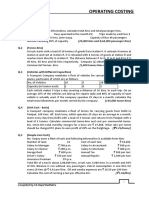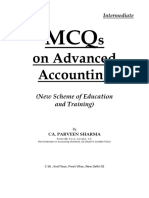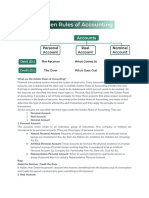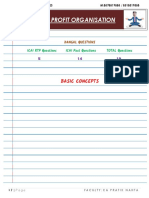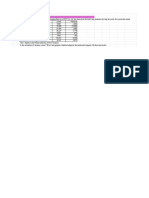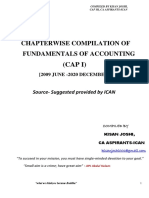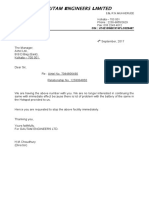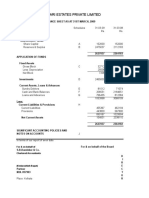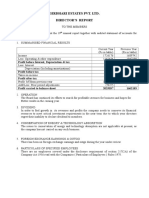Chapter 5 Depreciation Accounting PDF
Chapter 5 Depreciation Accounting PDF
Uploaded by
ravibhartia1978Copyright:
Available Formats
Chapter 5 Depreciation Accounting PDF
Chapter 5 Depreciation Accounting PDF
Uploaded by
ravibhartia1978Original Title
Copyright
Available Formats
Share this document
Did you find this document useful?
Is this content inappropriate?
Copyright:
Available Formats
Chapter 5 Depreciation Accounting PDF
Chapter 5 Depreciation Accounting PDF
Uploaded by
ravibhartia1978Copyright:
Available Formats
CHAPTER - 5
DEPRECIATION
ACCOUNTING
The Institute of Chartered Accountants of India
DEPRECIATION ACCOUNTING
Learning Objectives
After studying this chapter, you will be able to :
Grasp the meaning and nature of depreciation.
Determine the amount of depreciation from the total value of the fixed assets and its useful
life.
Understand various methods of depreciation and learn advantages and disadvantages of
such methods.
To calculate the amount of profit or loss resulting from the sale/ disposal of depreciable
assets.
Familiarize with the accounting treatment for change in the method of depreciation from
Straight Line Method to Reducing Balance method.
1. INTRODUCTION
Fixed assets like plant and machinery etc. are used in the business for the purpose of production of
goods or for providing useful services in the course of production. These fixed assets are utilized
during operations of a business for a number of successive accounting periods. Value of such
fixed assets decreases with passage of time and its utilization i.e. wear and tear. Value of portion
of fixed asset utilized for generating revenue must be recovered during a particular accounting
year to ascertain true income. This portion of cost of fixed asset allocated to a particular accounting
year is called depreciation.
1.1 CONCEPT OF DEPRECIATION
Depreciation has been defined as the diminution in the utility or value of an asset, due to natural
wear and tear, exhaustion of the subject-matter, effluxion of time accident, obsolescence or similar
causes. The words accident, obsolescence and the phrase effluxion of time included in the
definition, signify that when an asset held by a business cannot be employed for even one of the
purposes for which it was acquired due to some damage suffered, the assets having become out
of date or due to no occasion having arisen for it to be used, the loss caused to the business will
be depreciation. Depreciation caused by any one of the last mentioned factors often is described
as external depreciation, to distinguish it from the natural wear and tear of assets which is known
as internal depreciation.
is a measure of wearing out, consumption or other loss of value of a depreciable
Depreciation asset arising from use, effluxion of time or obsolescence through technology
and market changes. Depreciation is allocated so as to charge a fair proportion
of the depreciable amount in each accounting period during the expected useful life of the asset.
Depreciation includes amortisation of asset whose useful life is predetermined.
are those which (i) are expected to be used during more than one accounting
Depreciable
period; and (ii) have a limited useful life; and (iii) are held by an enterprise for
Assets
use in the production or supply of goods and services for rental to others or
for administrative purposes and not for the purpose of sale in the ordinary
course of business.
5.2 COMMON PROFICIENCY TEST
The Institute of Chartered Accountants of India
The loss in the value of assets employed for carrying on a business being an essential element of
business expenditure, it is necessary to calculate the amount of such loss and to make a provision,
and therefore, arrive at the amount of profit or loss made by the business.
Basically, the cost of an asset used for purpose of business has to be written off over its economic
(not physical) life which necessarily must be estimated. A point to remember is that usually, at
the end of the economic life, an asset has some value as scrap or otherwise. The amount to be
written off in each year should be as such which will reduce the book value of the asset, at the
end of its economic life, to its estimated scrap value.
A pertinent question, of course, is the price likely to prevail at the time of replacement. That
is why some people advocate the calculation of depreciation on the basis of replacement price
rather than cost.
1.2 OBJECTIVES FOR PROVIDING DEPRECIATION
Prime objectives for providing depreciation are:
(1) Correct income measurement: Depreciation should be charged for proper estimation of periodic
profit or loss.
(2) True position statement: Value of the fixed assets should be adjusted for depreciation charged
in order to depict the actual financial position.
(3) Funds for replacement: Generation of adequate funds in the hands of the business for
replacement of the asset at the end of its useful life.
(4) Ascertainment of true cost of production: For ascertaining the cost of the production, it is necessary
to charge depreciation as an item of cost of production.
Further depreciation is a non-cash expense and unlike other normal expenditure (e.g. wages, rent,
etc.) does not result in any cash outflow. Further depreciation by itself does not create funds it
merely draws attention to the fact that out of gross revenue receipts, a certain amount should be
retained for replacement of assets used for carrying on operation.
Objectives of providing
depreciation
To present true To accumulate funds
To ascertain true To ascertain true
and fair view of the for the replacement
results of operations costs of production
financial position of assets
FUNDAMENTALS OF ACCOUNTING 5.3
The Institute of Chartered Accountants of India
DEPRECIATION ACCOUNTING
2. FACTORS IN THE MEASUREMENT OF DEPRECIATION
Estimation of exact amount of depreciation is not easy. Generally following factors are taken into
consideration for calculation of depreciation.
1. Cost of asset including expenses for installation, commissioning, trial run etc.
2. Estimated useful life of the asset.
3. Estimated scrap value (if any) at the end of useful life of the asset.
The above mentioned factors can be explained, in detail, as follows:
Cost of a depreciable asset represents its money outlay or its
Cost of
Historical
equivalent in connection with its acquisition, installation and
asset
commissioning as well as for additions to or improvement
thereof for the purpose of increase in efficiency.
Useful Life is either (i) the period over which a depreciable
Useful life of
asset is expected to be used by the enterprise or (ii) the number
the asset
of production or similar units expected to be obtained from
Estimated
the use of the asset by the enterprise. Determination of the
useful life is a matter of estimation and is normally based
on various factors including experience with similar type of
assets. Several other factors like estimated working hours,
production capacity, repairs and renewals, etc. are also taken
into consideration on demanding situation.
Determination of the residual value is normally a difficult
Scrap
matter. If such value is considered as insignificant, it is
Estimated
(residual)
value normally regarded as nil. On the other hand, if the residual
value is likely to be significant, it is estimated at the time
of acquisition/installation, or at the time of subsequent
revaluation of asset.
Depreciable amount of a depreciable asset is its historical cost,
Depreciable or other amount substituted for historical cost in the financial
amount statements, less the estimated residual value.
For example, a machinery is purchased for ` 11,000. The residual value is
estimated at ` 1,000. It is estimated that the machinery will work for 5 years.
The cost to be allocated as depreciation in the accounting periods will be
calculated as:
`
Acquisition cost 11,000
Less: Residual value 1,000
Depreciable amount 10,000
Estimated useful life of the asset 5 years
5.4 COMMON PROFICIENCY TEST
The Institute of Chartered Accountants of India
`
Depreciation = i.e. = ` 2,000 per year
Factors affecting the
amount of depreciation
Cost of asset Expected useful life Estimated residual
value
3. METHODS FOR PROVIDING DEPRECIATION
Generally, methods for providing depreciation are based on formula, developed on a study of the
behaviour of the assets over a period of years for readily computing the amount of depreciation
suffered by different forms of assets. Each of the methods, however, should be applied only after
carefully considering nature of the asset and the conditions under which it is being used.
The two most common methods for providing depreciation are the Straight Line Method and the
Reducing Balance Method. The Straight Line Method is the most suitable and accurate method
to adopt in most cases. The Income Tax Rules, however, prescribe the Reducing Balance Method
except in the case of assets of an undertaking engaged in generation and distribution of power.
3.1 STRAIGHT LINE METHOD
According to this method, an equal amount is written off every year during the working life of
an asset so as to reduce the cost of the asset to nil or its residual value at the end of its useful life.
The advantage of this method is that it is simple to apply and gives accurate results especially in
case of leases, patents and copy rights, and also in case of plant and machinery. Calculation of
depreciation for additions to plant and machinery may be a complicated affair unless different
classes of machines are classified separately in a plant register based on year of additions. This
method is also known as Fixed Instalment Method.
Straight Line Depreciation =
Straight Line Depreciation Rate = x 100
The underlying assumption of this method is that the particular asset generates equal utility
during its lifetime. But this cannot be true under all circumstances. The expenditure incurred on
repairs and maintenance will be low in earlier years, whereas the same will be high as the asset
becomes old. Apart from this the asset may also have varying capacities over the years, indicating
FUNDAMENTALS OF ACCOUNTING 5.5
The Institute of Chartered Accountants of India
DEPRECIATION ACCOUNTING
logic for unequal depreciation provision. However, many assets have insignificant repairs and
maintenance expenditures for which straight line method can be applied.
3.2 REDUCING BALANCE METHOD
Under this system, a fixed percentage of the diminishing value of the asset is written off each year
so as to reduce the asset to its break - up value at the end of its life, repairs and small renewals
being charged to revenue. This method is commonly used for plant, fixtures, etc. Under this
method, the annual charge for depreciation decreases from year to year, so that the earlier years
suffer to the benefit of the later years. Also, under this method, the value of asset can never be
completely extinguished, which happens in the earlier explained Straight Line Method. However,
it is very simple to operate. The other advantage of this method is that the total charge to revenue
is uniform when the depreciation is high, repairs are negligible; and as the repairs increase, the
burden of depreciation gets lesser and lesser. On the other hand, under the Straight Line Method,
the charge for depreciation is constant, while repairs tend to increase with the life of the asset.
Among the disadvantages of this method is the danger that too low a percentage may be adopted
as depreciation with the result that over the life of the asset full depreciation may not be provided;
also if assets are grouped in such a way that individual assets are difficult to identify, the residue
of an asset may lie in the asset account even after the asset has been scrapped. The last mentioned
difficulty could be, however, over come if a Plant register is maintained.
The rate of depreciation under this method may be determined by the following formula:
where, n = useful life
Accounting Entries under Straight Line and Reducing Balance Methods :
There are two alternative approaches for recording accounting entries for depreciation.
First Alternative
A provision for depreciation account is opened to accumulate the balance of depreciation and
the assets are carried at historical cost.
Accounting entry
Profit and Loss Account Dr.
To Provision for Depreciation Account
Second Alternative
Amount of Depreciation is credited to the Asset Account every year and the Asset Account is
carried at historical cost less depreciation.
Accounting entries:
Depreciation Account Dr.
To Asset Account
Profit and Loss Account Dr.
To Depreciation Account
5.6 COMMON PROFICIENCY TEST
The Institute of Chartered Accountants of India
Illustration 1
Jain Bros. acquired a machine on 1st July, 2010 at a cost of ` 14,000 and spent ` 1,000 on its
installation. The firm writes off depreciation at 10% p.a. of the original cost every year. The books
are closed on 31st December every year. Show the Machinery Account and Depreciation Account
for the year 2010 and 2011.
Solution
As per Straight Line Method
Machinery Account
Dr. Cr.
2010 ` 2010 `
July 1 To Bank A/c 14,000 Dec. 31 By Depreciation A/c
July 1 To Bank A/c - 10% on ` 15,000 for 750
Installation Expenses 1,000 6 months
Dec. 31 By Balance c/d 14,250
15,000 15,000
2011 2011
Jan. 1 To Balance b/d 14,250 Dec. 31 By Depreciation A/c
10% on ` 15,000 1,500
Dec. 31 By Balance c/d 12,750
14,250 14,250
Depreciation Account
2010 ` 2010 `
Dec. 31 To Machinery A/c 750 Dec. 31 By Profit & Loss A/c 750
2011 2011
Dec. 31 To Machinery A/c 1,500 Dec. 31 By Profit & Loss A/c 1,500
Illustration 2
Jain Bros. acquired a machine on 1st July, 2010 at a cost of ` 14,000 and spent ` 1,000 on its
installation. The firm writes off depreciation at 10% p.a. every year. The books are closed on 31st
December every year. Show the Machinery Account on diminishing balance method for the year
2010 and 2011.
FUNDAMENTALS OF ACCOUNTING 5.7
The Institute of Chartered Accountants of India
DEPRECIATION ACCOUNTING
Solution
As per Reducing Balance Method
Machinery Account
2010 ` 2010 `
July 1 To Bank A/c 14,000 Dec. 31 By Depreciation A/c 750
To Bank A/c 1,000 (` 15,000 x 10% x 6/12)
Dec. 31 By Balance c/d 14,250
15,000 15,000
2011 2011
Jan. 1 To Balance b/d 14,250 Dec. 31 By Depreciation A/c 1,425
(` 14,250 x 10%)
Dec. 31 By Balance c/d 12,825
14,250 14,250
3.3 SUM OF YEARS OF DIGITS METHOD
It is variation of the Reducing Balance Method. In this case, the annual depreciation is calculated
by multiplying the original cost of the asset less its estimated scrap value by the fraction represented
by :
The number of years (including the present year) of remaining life of the asset
Total of all digits of the life of the asset (in years)
Suppose the estimated life of an asset is 10 years; the total of all the digits from 1 to 10 is 55 i.e.,10
+ 9 + 8 + 7 + 6 + 5 + 4 + 3 + 2 + 1, or by the formula:
=
= 55
The depreciation to be written off in the first year will be 10/55 of the cost of the asset less
estimated scrap value; and the depreciation for the second year will be 9/55 of the cost of asset
less estimated scrap value and so on.
The method is not yet in vogue in india; and its advantages are the same as those of the Reducing
Balance Method.
Illustration 3
M/s Raj & Co. purchased a machine for ` 1,00,000. Estimated useful life and scrap value were
10 years and ` 12,000 respectively. The machine was put to use on 1.1.2006. Show Machinery
Account and Depreciation Account in their books for 2011 by using sum of years digits method.
5.8 COMMON PROFICIENCY TEST
The Institute of Chartered Accountants of India
Solution
In the books of M/s Raj & Co.
Machinery Account
Dr. Cr.
2011 ` 2011 `
Jan. 1 To Balance b/d (W.N.2) 36,000 Dec. 31 By Depreciation A/c (W.N.3) 8,000
Dec. 31 By Balance c/d 28,000
36,000 36,000
2012
Jan.1 To Balance b/d 28,000
Depreciation Account
2011 ` 2011 `
Dec. 31 To Machinery A/c 8,000 Dec. 31 By Profit and Loss A/c 8,000
8,000 8,000
Working Notes :
(1) Total of sum of digit of depreciation for 2006-2010
= (` 1,00,000 - ` 12,000) 10 + 9 + 8 + 7 + 6
10(10 + 1)
2
= ` 88,000 = ` 64,000
(2) Written down value as on 1-1-2011
` 1,00,000 - ` 64,000 = ` 36,000
(3) Depreciation for 2011
(` 1,00,000 - ` 12,000) = ` 8,000.
3.4 ANNUITY METHOD
This is a method of depreciation which also takes into account the element of interest on capital
outlay and seeks to write off the value of the asset as well as the interest lost over the life of the
asset. It assumes that the amount laid out in acquiring asset, if invested elsewhere, would have
earned interest which must be reckoned as part of the cost of asset. On that basis, the amount of
depreciation to be annually provided in the accounts is ascertained from the Annuity Tables, to
write off each year interest on the capital outlay as well as part of the capital sum at a rate that the
whole of the capital sum and interest accruing thereon would be written off over the life of the
FUNDAMENTALS OF ACCOUNTING 5.9
The Institute of Chartered Accountants of India
DEPRECIATION ACCOUNTING
asset. Though the amount written off annually is constant, the interest in the earlier years being
greater, only small amount of the capital outlay is written off. This proportion is reversed with
the passage of time. This method is eminently suitable for writing off the amounts paid for long
leases which involve a considerable capital outlay. It is not practicable to adopt this method for
writing off depreciation of plant and machinery on account of frequent changes in the value of
such assets which would necessitate the recalculation of the amount of depreciation to be written
off annually.
Relevant Journal entries are:
(1) For charging interest on asset account
Asset Account Dr.
To Interest Account
(2) For charging depreciation on asset
Depreciation Account Dr.
To Asset Account
(3) For transferring depreciation to Profit and Loss Account
Profit and Loss Account Dr.
To Depreciation Account
(4) For transferring interest to Profit and Loss Account
Interest Account Dr.
To Profit and Loss Account
Illustration 4
A lease is purchased on 1st January, 2008 for 4 years at a cost of ` 20,000. It is proposed to depreciate
the lease by the annuity method charging 5 percent interest. A reference to the annuity table
shows that to depreciate Re. 1 by annuity method over 4 years charging 5% interest, one must
write off a sum of ` 0.282012 [To write off ` 20,000 one has to write off every year ` 5,640.24 i.e.
0.282012 20,000].
Show the Lease Account for four years and also the relevant entries in the profit and loss account.
5.10 COMMON PROFICIENCY TEST
The Institute of Chartered Accountants of India
Solution
Lease Account
Dr. Cr.
2008 ` 2008 `
Jan. 1 To Bank A/c 20,000.00 Dec. 31 By Depreciation A/c 5,640.24
Dec. 31 To Interest A/c By Balance c/d 15,359.76
(5% on ` 20,000) 1,000.00
21,000.00 21,000.00
2009 2009
Jan. 1 To Balance b/d 15,359.76 Dec.31 By Depreciation A/c 5,640.24
Dec. 31 To Interest A/c By Balance c/d 10,487.51
(5% on ` 15,359.76) 767.99
16,127.75 16,127.75
2010 2010
Jan. 1 To Balance b/d 10,487.51 Dec. 31 By Depreciation A/c 5,640.24
Dec. 31 To Interest A/c 524.38 Dec. 31 By Balance c/d 5,371.65
11,011.89 11,011.89
2011 2011
Jan. 1 To Balance b/d 5,371.65 Dec. 31 By Depreciation A/c 5,640.24
Dec. 31 To Interest A/c 268.59
5,640.24 5,640.24
Profit and Loss Account
2008 ` 2008 `
Dec. 31 To Depreciation A/c 5,640.24 Dec. 31 By Interest A/c 1,000.00
2009 2009
Dec. 31 To Depreciation A/c 5,640.24 Dec. 31 By Interest A/c 767.99
2010 2010
Dec. 31 To Depreciation A/c 5,640.24 Dec. 31 By Interest A/c 524.38
2011 2011
Dec. 31 To Depreciation A/c 5,640.24 Dec. 31 By Interest A/c 268.59
FUNDAMENTALS OF ACCOUNTING 5.11
The Institute of Chartered Accountants of India
DEPRECIATION ACCOUNTING
3.5 SINKING FUND METHOD
If a large sum of money is required for replacement of an asset at the end of its effective life, it
may not be advisable to leave in the amount of depreciation set apart annually, for it may or may
not be available in the form of the readily realisable assets to the concern at the time it is required.
To safeguard this position, the amount annually provided for depreciation may be placed to the
credit of the Sinking Fund Account, and at the same time an equivalent amount may be invested
in Government securities. The interest on these securities, when received, would be re-invested
and the amount thereof would be credited to the Sinking Fund Account. The amount of annual
provision for depreciation in such a case is calculated after taking into account interest, that the
amounts annually invested shall be earning over the period these will remain invested. When
the asset is due for replacement, the securities are sold and the new asset is purchased with the
proceeds of their sale. The book value of the old asset, at the time, is transferred to the Sinking
Fund Account. Any amount realised on sale of the old asset, as well as the profit or loss on sale
of securities, is transferred to the Sinking Fund Account and it is closed off by transfer of the
balance of the Profit and Loss Account or General Reserve.
The amount to be set apart annually be way of depreciation is ascertained from Sinking Fund
tables. They readily show the amount which must be invested each year to accumulate to Re. 1
at a given rate of interest within the stated period.
Relevant Journal entries are:
(1) For transfer of depreciation to Sinking Fund
Depreciation Account Dr.
To Sinking Fund Account
(2) For charging depreciation to profit and loss account
Profit and Loss Account Dr.
To Depreciation Account
(3) For investment of amount of depreciation
Sinking Fund Investment Account Dr.
To Bank Account
(4) In subsequent years, for interest earned on sinking fund investment and on investment of
the interest and depreciation
Bank Account Dr.
To Interest on Sinking Fund Investment Account
Interest on Sinking Fund Investment Account Dr.
To Sinking Fund Account
(In addition to these entries, entries (1) and (2) will also be passed in subsequent years for transfer
of depreciation to sinking fund and for charging it to profit and loss account)
5.12 COMMON PROFICIENCY TEST
The Institute of Chartered Accountants of India
Sinking Fund Investment Account Dr.
To Bank Account
(yearly depreciation + interest earned)
(5) For sale of sinking fund investment at the end of useful life of the asset
Bank Account Dr.
To Sinking Fund Investment Account
If sales is at a profit
Sinking Fund Investment Account Dr.
To Sinking Fund Account
If sales is at loss
Sinking Fund Account Dr.
To Sinking Fund Investment Account
(6) For transfer of the amount to the extent of book value of the asset from asset account to
sinking fund account
Sinking Fund Account Dr.
To Asset Account
(7) Any surplus in Sinking Fund Account may be transferred to General Reserve Account and
if any deficit, that may be transferred to Profit and Loss Account
Sinking Fund Account Dr.
To General Reserve Account
OR
Profit and Loss Account Dr.
To Sinking Fund Account
The aforementioned method may also be operated a little differently. The amount set apart
on account of depreciation, instead of being invested annually in the purchase of government
securities may be paid out as premium on a policy maturing at the end of the life of the asset, for
an amount equal to the sum that will be required for its replacement. In that case the amount of the
premium when paid will be debited to the Policy Account instead of the Investment Account.
Illustration 5
On 1st January, 2009, Z Limited purchased the lease of property for ` 10,000. The lease would
expire on 31st December, 2011. Z Ltd., decided to set up a sinking fund. The Sinking Fund was to
be credited (or debited) with an annual contribution from profit, the interest on the investments
and any profits (or losses) made on the realisation of the sinking fund investments. The sinking
fund was to be represented by specific investment, and any sums made available to the sinking
fund were to be immediately invested, except at the termination of the fund.
During the three years following transactions took place:
2009 31st December: A contribution from profits of ` 3,200 was made and this sum was
invested.
FUNDAMENTALS OF ACCOUNTING 5.13
The Institute of Chartered Accountants of India
DEPRECIATION ACCOUNTING
2010 13th July: Investments which originally costed ` 1,100 were sold for ` 1,200 and the proceeds
of sale were re-invested.
2010 31st December: A contribution from profits of ` 3,200 was made; interest on investments of
` 160 was received and these amounts were reinvested.
2011 9th May: Investments which originally costed ` 2,100 were sold at a profit of ` 200 and
proceeds of sale were re-invested.
2011 31st December: Interest on investments ` 480 was received which was not invested. All existing
investments were sold for ` 6,600. A contribution from profit of an amount required to make up
the sinking fund to ` 10,000 was made and this amount was not invested.
You are required to prepare Sinking Fund and Sinking Fund Investment Account for the years
2009-2011.
Solution
Sinking Fund Account
2009 ` 2009 `
Dec. 31 To Balance c/d 3,200 Dec. 31 By Depreciation A/c 3,200
3,200 3,200
2010 2010
Dec. 31 To Balance c/d 6,660 Jan. 1 By Balance b/d 3,200
July 13 By S.F. Investment A/c 100
Dec. 31 By Interest on
S.F.Investment A/c 160
By Depreciation A/c 3,200
6,660 6,660
2011 2011
Dec.31 To S.F. Investment A/c 260 Jan. 1 By Balance b/d 6,660
To Lease A/c 10,000 May 9 By S.F. Investment A/c 200
Dec. 31 By Interest on S.F. 480
Investment A/c
By Depreciation A/c 2,920
(Balancing Figure)
10,260 10,260
5.14 COMMON PROFICIENCY TEST
The Institute of Chartered Accountants of India
Sinking Fund Investment Account
2010 ` 2010 `
Dec. 31 To Bank A/c 3,200 Dec. 31 By Balance c/d 3,200
3,200 3,200
2010 2010
Jan. 1 To Balance b/d 3,200 July 13 By Bank (sale) 1,200
July 13 To S.F.A/c 100 Dec. 31 By Balance c/d 6,660
(profit on sale)
July 13 To Bank A/c 1,200
(investment of sale
proceed)
Dec. 31 To Bank A/c 3,360
(investment of
depreciation amount
and interest) 7,860 7,860
2011 2011
Jan. 1 To Balance b/d 6,660 May 9 By Bank 2,300
May 9 To S.F. A/c 200 Dec.31 By Bank 6,600
(profit on sale) Dec. 31 By S.F. A/c
May 9 To Bank A/c (investment 2,300 (loss on sale) 260
of sale proceeds) 9,160 9,160
Illustration 6
On the basis of the data given in the illustration 5, prepare Lease Account and Depreciation
Account for the years 2009-2011.
Solution
Lease Account
2009 ` 2009 `
Jan.1 To Bank A/c 10,000 Dec. 31 By Balance c/d 10,000
10,000 10,000
2010 2010
Jan. 1 To Balance b/d 10,000 Dec.31 By Balance c/d 10,000
10,000 10,000
2011 2011
Jan.1 To Balance b/d 10,000 Dec. 31 By Sinking Fund A/c 10,000
10,000 10,000
FUNDAMENTALS OF ACCOUNTING 5.15
The Institute of Chartered Accountants of India
DEPRECIATION ACCOUNTING
Depreciation Account
2009 ` 2009 `
Dec. 31 To Sinking Fund A/c 3,200 Dec. 31 By Profit & Loss A/c 3,200
3,200 3,200
2010 2010
Dec. 31 To Sinking Fund A/c 3,200 Dec. 31 By Profit & Loss A/c 3,200
3,200 3,200
2011 2011
Dec. 31 To Sinking Fund A/c 2,920 Dec. 31 By Profit & Loss A/c 2,920
2,920 2,920
3.6 MACHINE HOUR METHOD
Where it is practicable to keep a record of the actual running hours of each machine, depreciation
may be calculated on the basis of hours that the concerned machine worked. The machine hour
rate of the depreciation, is calculated after estimating the total number of hours that machine
would work during its whole life; however, it may have to be varied from time to time, on a
consideration of the changes in the economic and technological conditions which might take place,
to ensure that the amount provided for depreciation corresponds to that considered appropriate
in the changed circumstances. It would be observed that the method is only a slight variation of
the Straight Line Method under which depreciation is calculated per year. Under this method it
is calculated for each hour the machine works.
Illustration 7
A machine was purchased for ` 3,00,000 having an estimated total working of 24,000 hours. The
scrap value is expected to be ` 20,000 and anticipated pattern of distribution of effective hours
is as follows :
Year
1 - 3 3,000 hours per year
4 - 6 2,600 hours per year
7 - 10 1,800 hours per year
Determine Annual Depreciation under Machine Hour Rate Method.
Solution
Statement of Annual Depreciation under Machine Hours Rate Method
Year Annual Depreciation
3,000
1 - 3 (` 3,00,000 - ` 20,000) = ` 35,000
24,000
5.16 COMMON PROFICIENCY TEST
The Institute of Chartered Accountants of India
4 - 6 2,600 (` 3,00,000 - ` 20,000) = ` 30,333
24,000
7 - 10 1,800 (` 3,00,000 - ` 20,000) = ` 21,000
24,000
3.7 PRODUCTION UNITS METHOD
Under this method depreciation of the asset is determined by comparing the annual production
with the estimated total production. The amount of depreciation is computed by the use of
following method :
Depreciation for the period = Depreciable Amount
The method is applicable to machines producing product of uniform specifications.
Illustration 8
A machine is purchased for ` 2,00,000. Its estimated useful life is 10 years with a residual value
of ` 20,000. The machine is expected to produce 1.5 lakh units during its life time. Expected
distribution pattern of production is as follows:
Year Production
1-3 20,000 units per year
4-7 15,000 units per year
8-10 10,000 units per year
Determine the value of depreciation for each year using production units method.
Solution
Statement showing Depreciation under Production Units Method
Year Annual Depreciation
1-3 20,000 (` 2,00,000 - ` 20,000) = ` 24,000
1,50,000
15,000
4-7 (` 2,00,000 - ` 20,000 ) = ` 18,000
1,50,000
10,000
8-10 1,50,000 (` 2,00,000 - ` 20,000) = ` 12,000
FUNDAMENTALS OF ACCOUNTING 5.17
The Institute of Chartered Accountants of India
DEPRECIATION ACCOUNTING
3.8 DEPLETION METHOD
This method is used in case of mines, quarries etc. containing only a certain quantity of product.
The depreciation rate is calculated by dividing the cost of the asset by the estimated quantity of
product likely to be available. Annual depreciation will be the quantity extracted multiplied by
the rate per unit.
Illustration 9
M/s Jay & Co. took lease of a quarry on 1-1-2009 for ` 1,00,00,000. As per technical estimate the
total quantity of mineral deposit is 2,00,000 tonnes. Depreciation was charged on the basis of
depletion method. Extraction pattern is given in the following table:
Year Quantity of Mineral extracted
2009 2,000 tonnes
2010 10,000 tonnes
2011 15,000 tonnes
Show the Quarry Lease Account and Depreciation Account for each year from 2009 to 2011.
Solution
Quarry Lease Account
Dr. Cr.
2009 ` 2009 `
Jan. To Bank A/c 1,00,00,000 Dec. 31 By Depreciation A/c 1,00,000
[(2,000/2,00,000)
` 1,00,00,000]
Dec. 31 By Balance c/d 99,00,000
1,00,00,000 1,00,00,000
2010 2010
Jan. 1 To Balance b/d 99,00,000 Dec. 31 By Depreciation A/c 5,00,000
Dec. 31 By Balance c/d 94,00,000
99,00,000 99,00,000
2011 2011
Jan. 1 To Balance b/d 94,00,000 Dec. 31 By Depreciation A/c 7,50,000
Dec. 31 By Balance c/d 86,50,00
94,00,000 94,00,000
5.18 COMMON PROFICIENCY TEST
The Institute of Chartered Accountants of India
Depreciation Account
Dr. Cr.
2009 ` 2009 `
Dec. 31 To Quarry lease A/c 1,00,000 Dec. 31 By Profit & Loss A/c 1,00,000
1,00,000 1,00,000
2010 2010
Dec. 31 To Quarry lease A/c 5,00,000 Dec. 31 By Profit & Loss A/c 5,00,000
5,00,000 5,00,000
2011 2011
Dec. 31 To Quarry lease A/c 7,50,000 Dec. 31 By Profit & Loss A/c 7,50,000
7,50,000 7,50,000
4. PROFIT OR LOSS ON THE SALE / DISPOSAL OF DEPRECIABLE ASSETS
Whenever any depreciable asset is sold during the year, depreciation is charged on it for the
period it has been used in the sale year. The written down value after charging such depreciation
is used for calculating the profit or loss on the sale of that asset. The resulting profit or loss on
sale of the asset is ultimately transferred to profit and loss account.
For example: The book value of the asset as on 1st January, 2011 is ` 50,000. Depreciation is charged
on the asset @10%. On 1st July 2011, the asset is sold for ` 32,000. In such a situation, profit or loss
on the sale will be calculated as follows:
`
Book value as on 1st Jan., 2011 50,000
Less: Depreciation for 6 months @10% (from 1 Jan., 2011 to 30 June, 2011)
st th
2,500
Written down value as on 1st July, 2011 47,500
Less: Sale proceeds as on 1st July, 2011 32,000
Loss on sale of the asset 15,500
Illustration 10
A firm purchased on 1st January, 2010 certain machinery for ` 58,200 and spent ` 1,800 on
its erection. On July 1, 2010 another machinery for ` 20,000 was acquired. On 1st July, 2011
the machinery purchased on 1st January, 2010 having become obsolete was auctioned for
` 38,600 and on the same date fresh machinery was purchased at a cost of ` 40,000.
Depreciation was provided for annually on 31st December at the rate of 10 per cent p.a. on written
down value. Prepare machinery account.
FUNDAMENTALS OF ACCOUNTING 5.19
The Institute of Chartered Accountants of India
DEPRECIATION ACCOUNTING
Solution
Machinery Account
Dr. Cr.
2010 ` 2010 `
Jan. 1 To Bank A/c 58,200 Dec. 31 By Depreciation A/c 7,000
Jan. 1 To Bank A/c
erection charges 1,800 By Balance c/d 73,000
July 1 To Bank A/c 20,000
80,000 80,000
2011 2011
Jan. 1 To Balance b/d 73,000 July 1 By Depreciation on
sold machine 2,700
July 1 To Bank A/c 40,000 By Bank A/c 38,600
By Profit and Loss A/c 12,700
Dec. 31 By Depreciation A/c 3,900
By Balance c/d 55,100
1,13,000 1,13,000
Working Note:
Book Value of Machines
Machine Machine Machine
I II III
` ` `
Cost 60,000 20,000 40,000
Depreciation for 2010 6,000 1,000
Written down value 54,000 19,000
Depreciation for 2011 2,700 1,900 2,000
Written down value 51,300 17,100 38,000
Sale Proceeds 38,600
Loss on Sale 12,700
5.20 COMMON PROFICIENCY TEST
The Institute of Chartered Accountants of India
Illustration 11
A companys plant and machinery account at 31st December, 2011 and the corresponding
depreciation provision account, broken down by year of purchase are as follows:
Year of Purchase Plant and Machinery at cost Depreciation Provision
1995 20,000 20,000
2001 30,000 30,000
2002 1,00,000 95,000
2003 70,000 59,500
2010 50,000 7,500
2011 30,000 1,500
3,00,000 2,13,500
Depreciation is at the rate of 10% per annum on cost. It is the Companys policy to assume that
all purchases, sales or disposal of plant occurred on 30th June in the relevant year for the purpose
of calculating depreciation, irrespective of the precise date on which these events occurred.
During 2012 the following transactions took place:
1. Purchase of plant and machinery amounted to ` 1,50,000
2. Plant that had been bought in 2001 for ` 17,000 was scrapped.
3. Plant that had been bought in 2002 for ` 9,000 was sold for 500.
4. Plant that had been bought in 2003 for ` 24,000 was sold for ` 1,500.
You are required to:
Calculate the provision for depreciation of plant and machinery for the year ended 31st December,
2012. In calculating this provision you should bear in mind that it is the companys policy to show
any profit or loss on the sale or disposal of plant as a completely separate item in the Profit and
Loss Account.
FUNDAMENTALS OF ACCOUNTING 5.21
The Institute of Chartered Accountants of India
DEPRECIATION ACCOUNTING
Solution
Calculation of provision for depreciation of plant and machinery for the year ended 31st
December, 2012.
Plant purchased in: ` `
1995 nil
2001 nil
2002 5,000
2003 1/2 year at 10% on ` 24,000 1,200
1 year at 10% on ` 46,000 4,600 5,800
2010 10% on ` 50,000 5,000
2011 10% on ` 30,000 3,000
2012 1/2 year at 10% on ` 1,50,000 7,500
26,300
Illustration 12
Prepare the following ledger accounts during 2012 from the information given in
illustration 11 :
(i) plant and machinery at cost ;
(ii) depreciation provision;
(iii) sales or disposal of plant and machinery.
Solution
(i) Plant and Machinery Account (for 2012) at Cost
` `
To Balance b/d 3,00,000 By Disposals account:
To Purchases A/c 1,50,000 Scrapped 17,000
Sold 33,000
By Balance c/d 4,00,000
4,50,000 4,50,000
5.22 COMMON PROFICIENCY TEST
The Institute of Chartered Accountants of India
(ii) Depreciation Provision Account (for 2012)
` `
To Disposal Account : By Balance b/d 2,13,500
Scrapped - 2001 assets 17,000 By Profit and Loss Account 26,300
Sold - 2002 assets 9,000
Sold - 2003 assets 21,600 47,600
To Balance c/d 1,92,200
2,39,800 2,39,800
(iii) Sale or disposal of Plant and Machinery Account (for 2012)
` `
To Plant and Machinery : By Provision for Depreciation 47,600
Scrapped 17,000 By Cash-Sales Proceeds 2,000
Sold 33,000 By Loss on sales 400
50,000 50,000
Illustration 13
The Machinery Account of a Factory showed a balance of ` 1,90,000 on 1st January, 2012. Its
accounts were made up on 31st December each year and depreciation is written off at 10% p.a.
under the Diminishing Balance Method.
On 1st June 2012, a new machinery was acquired at a cost of ` 28,000 and installation charges
incurred in erecting the machine works out to ` 892 on the same date. On 1st June, 2012 a machine
which had cost ` 4,374 on 1st January 2010 was sold for ` 750. Another machine which had cost
` 437 on 1st January, 2011 was scrapped on the same date and it realised nothing.
Write a plant and machinery account for the year 2012, allowing the same rate of depreciation as
in the past calculating depreciation to the nearest multiple of a Rupee.
FUNDAMENTALS OF ACCOUNTING 5.23
The Institute of Chartered Accountants of India
DEPRECIATION ACCOUNTING
Solution
Plant and Machinery Account
Dr. Cr.
2012 ` 2012 `
Jan. 1 To Balance b/d 1,90,000 June 1 By Bank (Sales) 750
June. 1 To Bank (28,000 + 892) 28,892 By Depreciation (on sold 148
machine)
By Loss on sale 2,645
By Loss on scrapping the 377
machine
By D e p r e c i a t i o n ( o n 16
scrapped machinery)
By Depreciation (Note iii) 20,291
By Balance c/d 1,94,665
2,18,892 2,18,892
Working Note :
(i) Calculation of loss on sale of machine on 1-6-2012
`
Cost on 1-1-2010 4,374
Less : Depreciation @ 10% on ` 4,374 (437)
W.D.V. on 31-12-2010 3,937
Less : Depreciation @ 10% on ` 3,937 (394)
W.D.V. on 31-12-2011 3,543
Less : Depreciation @ 10% on ` 3,543 for 5 months (148)
3,395
Less : Sale proceeds on 1-6-2012 (750)
Loss 2,645
(ii) Calculation of loss on scrapped machine
`
Cost on 1-1-2011 437
Less : Depreciation @ 10% on ` 437 (44)
W.D.V. on 1-1-2012 393
Less : Depreciation @ 10% on ` 393 for 5 months (16)
Loss 377
5.24 COMMON PROFICIENCY TEST
The Institute of Chartered Accountants of India
(iii) Depreciation
Balance of machinery account on 1-1-2012 1,90,000
Less : W.D.V.of machinery sold 3,543
W.D.V. of machinery scrapped 393 (3,936)
W.D.V. of other machinery on 1-1-2012 1,86,064
Depreciation @ 10% on ` 1,86,064 for 12 months 18,606
Depreciation @ 10% on ` 28,892 for 7 months 1,685
20,291
5. CHANGE IN THE METHOD OF DEPRECIATION
The depreciation method selected should be applied consistently from period to period. A change
from one method of providing depreciation to another should be made only if the adoption of
the new method is required by the statute or for compliance with the accounting standard or if it
is considered that the change would result in the more appropriate preparation and presentation
of the financial statements of the enterprise. Whenever any change in depreciation method is
made, depreciation should be recalculated in accordance with the new method from the date
of asset coming into use. The deficiency or surplus arising from retrospective recomputation of
depreciation should be debited or credited to Profit and Loss account in the year in which the
method of depreciation is changed. Such change is treated as change in accounting policy. Its
effect needs to be quantified and disclosed.
Example : Cost of Machine ` 1,05,000
Residual Value ` 5,000
Useful life 10 years
The company charges depreciation on straight line method for the first two years and thereafter
decides to adopt written down value method.
In this case: Rate of WDV depreciation (say `a) would be;
a=1-
After applying the log and antilog table, the rate of depreciation would be derived as follows:
a = 1-(5,000/1,05,000)1/10
a = 1-(1/21)1/10
Let (1/21)1/10 =a
Taking log both sides
Log a = 1/10(log1-log21)
= 1/10(0-1.3222)
= -0.13222
Adding and Subtracting 1 we get
FUNDAMENTALS OF ACCOUNTING 5.25
The Institute of Chartered Accountants of India
DEPRECIATION ACCOUNTING
bar 1.86778
Taking antilog both sides
a= antilog(bar 1.86778)
= 0.73753
Thus,
1 - 0.73753
= 0.26247 or 26.247%
Depreciation already charged for the first 2 years as per straight line method is ` 20,000.
Retrospective computation of depreciation as per WDV method:
Cost of Machine ` 1,05,000
Less : Depreciation for the 1st year @ 26.247% ` 27,559
WDV at the beginning of 2nd year ` 77,441
Less : Depreciation for the 2nd year @ 26.247% 20,326
WDV at the beginning of 3rd year ` 57,115
Less : Depreciation for the 3rd year @ 26.247% 14,991
42,124
WDV : Depreciation for first two years ` 47,885
Less : Depreciation already charged as per straight line method `
Rs. 1, 05, 000 `
Rs. 5, 000 x 2 (` 20,000)
10
Shortfall ` 27,885
Therefore in the profit and loss account of the 3rd year, the short depreciation due to change in
the method of depreciation of ` 27,885 should be debited. In addition, depreciation as per written
down value method for 3rd year of ` 14,991, should also be debited.
Illustration 14
A firm purchased on 1st January, 2009 certain machinery for ` 52,380 and spent ` 1,620 on its
erection. On January 1, 2009 another machinery for ` 19,000 was acquired. On 1st July, 2010 the
machinery purchased on 1st Januray, 2009 having become obsolete was auctioned for ` 28,600
and on the same date fresh machinery was purchased at a cost of ` 40,000.
Depreciation was provided annually on 31st December at the rate of 10 per cent on written down
value. In 2011, however, the firm changed this method of providing depreciation and adopted
the method of providing 5 per cent per annum depreciation on the original cost of the machinery
with retrospective effect.
5.26 COMMON PROFICIENCY TEST
The Institute of Chartered Accountants of India
Solution
Machinery Account
2009 ` 2009 `
Jan. 1 To Bank 52,380 Dec. 31 By Depreciation A/c 7,300
Jan. 1 To Bank-erection charges 1,620 By Balance c/d 65,700
Jan. 1 To Bank 19,000
73,000 73,000
2010 2010
Jan. 1 To Balance b/d 65,700 July 1 By Depreciation 2,430
July 1 To Bank 40,000 By Bank 28,600
By Profit and Loss A/c 17,570
Dec. 31 By Depreciation A/c 3,710
By Balance c/d 53,390
1,05,700 1,05,700
2011 2011
Jan. 1 To Balance b/d 53,390 Dec. 31 By Depreciation A/c 2,950
To Profit and Loss A/c By Balance c/d 53,150
(Excess Dep. written back)
2,710
56,100 56,100
Working Notes :
(1) Book Value of Machines:
Machine Machine Machine
I II III
` ` `
Cost 54,000 19,000 40,000
Depreciation for 2009 5,400 1,900
Written down value 48,600 17,100
Depreciation for 2010 2,430 1,710 2,000
Written down value 46,170 15,390 38,000
Sale Proceeds in 2011 28,600
Loss on Sale 17,570
FUNDAMENTALS OF ACCOUNTING 5.27
The Institute of Chartered Accountants of India
DEPRECIATION ACCOUNTING
(2) Written down value on the basis of 5% depreciation on straight line basis as at 31st Dec.,
2010.
Machine Machine
II III
` `
Cost 19,000 40,000
Less : Depreciation for 2 years 1,900
Depreciation for 1/2 year 1,000
17,100 39,000
Total ` 56,100
(3) The book value appearing in the books is ` 53,390; ` 2,710 has to be written back to make
this figure ` 56,100.
Note : The rate of 10% is assumed to be per annum.
Illustration 15
Messers Mill and Wright commenced business on 1st January 2007, when they purchased plant
and equipment for ` 7,00,000. They adopted a policy of (i) charging depreciation at 15% per annum
on diminishing balance basis and (ii) charging full years depreciation on additions.
Over the years, their purchases of plant have been:
Date Amount
`
1-8-2008 1,50,000
30-9-2011 2,00,000
On 1-1-2011 it was decided to change the method and rate of depreciation to 10% on straight
line basis with retrospective effect from 1-1-2007 the adjustment being made in the books of
account.
Calculate the difference in depreciation to be adjusted in the Plant and Equipment being made
in the accounts for the year ending 31st December, 2011.
5.28 COMMON PROFICIENCY TEST
The Institute of Chartered Accountants of India
Solution
Depreciation on written down value basis
Purchased on Purchased on Total
Jan. 1, 2007 Aug. 1, 2008 Depreciation
2007 ` ` `
Cost 7,00,000
Depreciation 1,05,000 1,05,000
Written Down Value (WDV) 5,95,000 1,50,000
2008
Depreciation 89,250 22,500 1,11,750
W.D.V. 5,05,750 1,27,500
2009
Depreciation 75,863 19,125 94,988
W.D.V. 4,29,887 1,08,375
2010
Depreciation 64,483 16,256 80,739
W.D.V. 3,65,404 92,119
Depreciation Charged 3,34,596 57,881
Total Depreciation Charged (A) 3,92,477
Depreciation on straight line basis :
` `
Annual Depreciation (10% of original 70,000 15,000
cost)
No. of years for which
depreciation is to be charged 4 3
Depreciation charged 2,80,000 45,000
Total (B) 3,25,000
Difference :
Excess depreciation charged to be adjusted in 2011 (A) (B) = ` 67,477.
Plant and Equipment Account
Dr. Cr.
2011 ` 2011 `
Jan. 1 To Balance b/d 4,57,523 Dec. 31 By Depreciation (10% of 1,05,000
original cost)
To Profit and Loss A/c
adjustment for
depreciation 67,477 By Balance c/d 6,20,000
Sep. 30 To Bank 2,00,000
7,25,000 7,25,000
2012
Jan. 1 To Balance b/d 6,20,000
FUNDAMENTALS OF ACCOUNTING 5.29
The Institute of Chartered Accountants of India
DEPRECIATION ACCOUNTING
6. REVISION OF THE ESTIMATED USEFUL LIFE OF THE
DEPRECIABLE ASSET
There should be a periodical review of useful life of the depreciable assets. Whenever there is a
revision in the estimated useful life of the asset, the unamortised depreciable amount should be
charged to the asset over the revised remaining estimated useful life of the asset.
Illustration 16
M/s. Mayur & Co. purchased a machine on 1.1.2006 for ` 20,00,000. Estimated useful life was 10
years and scrap value at the end was expected to be ` 2,00,000. On 1.1.2011, the written down value
of the machine was revalued to be up by 20%, useful life was re-estimated as 13 years and scrap
value as ` 2,80,000. The company follows reducing balance method of charging depreciation. Show
Machinery Account and Provision for Depreciation Account for the year ended 31.12.2011.
Solution
Machinery Account
Dr. Cr.
2011 ` 2011 `
Jan. 1 To Balance b/d 20,00,000 Dec. 31 By Balance c/d 21,26,492
To Revaluation
Reserve 1,26,492
21,26,492 21,26,492
Provision for Depreciation Account
Dr. Cr.
2011 ` 2011 `
Dec.31 To Balance c/d 14,56,480 Jan. 1 By Balance b/d 13,67,538
Dec. 31 By Profit and Loss 88,942
A/c
14,56,480 14,56,480
Working Notes:
(1) In the year 2004 : Calculation of rate of depreciation as per WDV method
= 1 10 2,00,000 100
20,00,000
After applying the log and antilog table, the rate of depreciation would be derived as follows:
= [1 -(1/10 log 20 - 1/10 log 200)] x 100
= [1 -(1/10 x 1.3010 - 1/10 x 2.3010)] x 100
5.30 COMMON PROFICIENCY TEST
The Institute of Chartered Accountants of India
= [1 -(.1301 - .2301)] x 100
= [1 -(.10)] x 100
= [1 -(Antilog - .10 + 1 - 1)] x 100
= [1 -(Antilog bar 1.90)] x 100
= [1 -0.7943] x 100
= .2057 x 100
= 20.57%
(2) Statement of Depreciation
`
1.1.2006 Cost of the machine 20,00,000
31.12.2006 Less : Depreciation 4,11,340
1.1.2007 W.D.V. 15,88,660
31.12.2007 Depreciation 3,26,740
1.1.2008 W.D.V. 12,61,920
31.12.2008 Depreciation 2,59,539
1.1.2009 W.D.V. 10,02,381
31.12.2009 Depreciation 2,06,160
1.1.2010 W.D.V. 7,96,221
31.12.2010 Depreciation 1,63,759
1.1.2011 W.D.V. 6,32,462
Add : Upward Revulation (20%)
1,26,492
7,58,954
31.12.2011 Depreciation
(11.719%* on ` 7,58,954) 88,942
1.1.2012 W.D.V. 6,70,012
(3) *In the year 2011 : Calculation of rate of depreciation as per WDV method
2,00,000
= 1 10 100 = 11.719%
20,00,000
7. REVALUATION OF DEPRECIABLE ASSETS
Whenever the depreciable asset is revalued, the depreciation should be charged on the revalued
FUNDAMENTALS OF ACCOUNTING 5.31
The Institute of Chartered Accountants of India
DEPRECIATION ACCOUNTING
amount on the basis of the remaining estimated useful life of the asset. If there is an upward revision
in the value of asset for the first time, then the amount of appreciation is debited to Asset Account
and credited to Revaluation Reserve Account. If an asset was earlier revalued downward and later
on revalued upward then the appreciation to the extent of earlier downfall is credited to profit
and loss account. If there is downward revision in the value of asset then Profit and Loss Account
is debited and Asset Account is credited. If an asset was earlier revalued upward and then later
on it was revalued downward then the downfall to the extent of earlier appreciation is debited
to Revaluation Reserve Account. In case the revaluation has a material effect on the amount of
depreciation, the same should be disclosed separately in the year in which revaluation is carried out.
Illustration 17
Consider the following details:
Machine A Machine B
Date of Purchase 1.1.2008 1.1.2010
Cost Price (` ) 12,25,000 15,75,000
Realisable Value (` ) 25,000 75,000
Useful Life 10 years 15 years
The machines were subject to depreciation under straight line basis. Calendar year is followed
as the accounting year. In 2010, Machine A was revalued upward by ` 2 lacs. From 1.1.2011,
it is decided to adopt written down value method of depreciation. You are asked to prepare a
statement showing depreciation charged on each machine upto 31.12.2011.
Solution
Statement of Depreciation
Machine A Machine B
` `
1.1.2008 Cost Price 12,25,000
31.12.2008 Less : SLM depreciation 1,20,000
1.1.2009 WDV 11,05,000
31.12.2009 Less : SLM depreciation 1,20,000
1.1.2010 WDV 9,85,000
1.1.2010 Cost Price 15,75,000
Upward Revaluation 2,00,000
11,85,000
31.12.2010 Less : SLM depreciation
11,85,000 25,000 1,45,000 1,00,000
8
1.1.2011 WDV 10,40,000 14,75,000
31.12.2011 Less : Retrospective effect of change
in the method of depreciation 5,42,450 1,89,800
4,97,550 12,85,200
31.12.2011 Less : WDV depreciation 1,73,147 2,36,477
3,24,403 10,48,723
5.32 COMMON PROFICIENCY TEST
The Institute of Chartered Accountants of India
Working Notes
(1) WDV Rates :
Machine A Machine B
2008 & 2010 2008 onward
1 1
25,000 10 75,000 15
1 = 32.2%* 1 = 18.4%*
12, 25,000 15,75,000
2010 onwards
1
25,000 8
1 = 34.8 %*
7,63,113
(2) Retrospective effect of depreciation Machine A Machine B
WDV depreciation for 2008 3,94,450
WDV depreciation for 2009 2,67,437
WDV depreciation for 2010 2,65,563 2,89,800
9,27,450 2,89,800
Less : SLM depreciation already charged 3,85,000 1,00,000
for the above period
Shortfall 5,42,450 1,89,800
8. PROVISION FOR REPAIRS AND RENEWALS
Expenditure incurred for repairs, renewals and maintenance on plant and machinery may vary
over the years during the working life. Thus, for equalising the charge of repairs and renewals,
sometimes a Provision for Repairs and Renewals Account is opened. Total of such expenses that
may be incurred over the working life is estimated before hand. Average of this expenditure is
debited to Profit and Loss Account and credited to Provision for Repairs and Renewals Account
irrespective of actual expenses incurred. Every year Provision for Repairs and Renewals Account
is debited and Repairs Account is credited for actual expenses incurred. The balance in provision
for Repairs and Renewals Account is carried forward and in the end or on sale of the asset, the
account is closed by transfer to the Asset Account for any balance left.
Illustration 18
The following particulars are available from the books of a public company having a large fleet
of vehicles :
`
Balance in Provision for Repairs and Renewals Account as on 31.3.2010 1,15,000
Actual repairs charged/incurred during the year ended
31.3.2010 75,000
31.3.2011 32,000
* The rate of depreciation has been calculated by applying log and antilog table.
FUNDAMENTALS OF ACCOUNTING 5.33
The Institute of Chartered Accountants of India
DEPRECIATION ACCOUNTING
The company makes an annual provision of ` 40,000 on repairs and renewals.
Draw up the Provision for Repairs and Renewals Account for the years 2009-2010 and 2010-2011.
Solution
Provision for Repairs and Renewal Account
Dr. Cr.
` `
31.3.2010 To Repairs A/c 75,000 1.4.2009 By Balance b/d 1,50,000
31.3.2010 To Balance c/d 1,15,000 (Balancing figure)
31.3.2010 By Profit and Loss A/c 40,000
1,90,000 1,90,000
31.3.2011 To Repairs A/c 32,000 1.4.2010 By Balance b/d 1,15,000
31.3.2011 To Balance c/d 1,23,000 31.3.2011 By Profit and Loss A/c 40,000
1,55,000 1,55,000
1.4.2011 By Balance b/d 1,23,000
SELF EXAMINATION QUESTIONS
Pick up the correct answer from the given choices:
1. Amit Ltd. purchased a machine on 01.01.2008 for ` 1,20,000. Installation expenses were
` 10,000. Residual value after 5 years ` 5,000. On 01.07.2008, expenses for repairs were
incurred to the extent of ` 2,000. Depreciation is provided @ 10% p.a. under written down
value method. Depreciation for the 4th year = ________.
(a) ` 25,000 (b) ` 13,000 (c) ` 10,530 (d) ` 9,477
2. Original cost = ` 1,26,000; Salvage value = Nil; Useful life = 6 years. Depreciation for the first
year under sum of years digits method will be
(a) ` 6,000 (b) ` 12,000 (c) ` 18,000 (d) ` 36,000
3. Obsolescence of a depreciable asset may be caused by
I. Technological changes.
II. Improvement in production method.
III. Change in market demand for the product or service output.
IV. Legal or other restrictions.
(a) Only (I) above (b) Both (I) and (II) above
(c) All (I), (II), (III) and (IV) above (d) Only (IV) above
5.34 COMMON PROFICIENCY TEST
The Institute of Chartered Accountants of India
4. Amit Ltd. purchased a machine on 01.01.2011 for ` 1,20,000. Installation expenses were
` 10,000. Residual value after 5 years ` 5,000. On 01.07.2011, expenses for repairs were incurred
to the extent of ` 2,000. Depreciation is provided under straight line method. Depreciation
rate = 10%. Annual Depreciation = _____.
(a) ` 13,000 (b) ` 17,000 (c) ` 21,000 (d) ` 25,000
5. Original cost = ` 1,26,000; Salvage value = Nil; Useful life = 6 years. Depreciation for the
fourth year under sum of years digits method will be
(a) ` 6,000 (b) ` 12,000 (c) ` 18,000 (d) ` 24,000
6. Which of the following statements is/are false?
I. The term depreciation, depletion and amortization convey the same meaning.
II. Provision for depreciation A/c is debited when provision for depreciation A/c is
created.
III. The main purpose of charging the profit and loss A/c with the amount of depreciation
is to spread the cost of an asset over its useful life for the purpose of income
determination.
(a) Only (I) above (b) Only (II) above
(c) Only (III) above (d) All (I) (II) and (III) above
7. Original cost = ` 1,26,000. Salvage value = 6,000. Depreciation for 2nd year by Units of
Production Method, if units produced in 2nd year was 5,000 and total estimated production
50,000.
(a) ` 10,800 (b) ` 11,340 (c) ` 12,600 (d) ` 12,000
8. The number of production of similar units expected to be obtained from the use of an asset
by an enterprise is called as
(a) Unit life (b) Useful life
(c) Production life (d) Expected life
9. Which of the following is not true with regard to fixed assets?
(a) They are acquired for using them in the conduct of business operations
(b) They are not meant for resale to earn profit
(c) They can easily be converted into cash
(d) Depreciation at specified rates is to be charged on most of the fixed assets
10. Original cost = ` 1,26,000. Salvage value = 6,000. Useful Life = 6 years. Annual depreciation
under SLM =
(a) ` 21,000 (b) ` 20,000 (c) ` 15,000 (d) ` 14,000
FUNDAMENTALS OF ACCOUNTING 5.35
The Institute of Chartered Accountants of India
DEPRECIATION ACCOUNTING
11. Original cost = ` 1,26,000. Salvage value = 6,000. Depreciation for 2nd year @ 10% p.a. under
WDV method =
(a) ` 10,800 (b) ` 11,340 (c) ` 15,000 (d) ` 14,000
12. Which of the following expenses is not included in the acquisition cost of a plant and
equipment?
(a) Cost of site preparation (b) Delivery and handling charges
(c) Installation costs
(d) Financing costs incurred subsequent to the period after plant and equipment is put to
use.
13. For charging depreciation, on which of the following assets, the depletion method is
adopted?
(a) Plant & machinery (b) Land & building
(c) Goodwill (d) Wasting assets like mines and quarries
14. If a concern proposes to discontinue its business from March 2011 and decides to dispose
of all its assets within a period of 4 months, the Balance Sheet as on March 31, 2011 should
indicate the assets at their
(a) Historical cost (b) Net realizable value
(c) Cost less depreciation (d) Cost price or market value, whichever is lower
15. In the case of downward revaluation of an asset which is for the first time revalued, the
account to be debited is
(a) Fixed Asset (b) Revaluation Reserve
(c) Profit & Loss account (d) General Reserve
16. In which of the following methods, is the cost of the asset written off in equal proportion,
during its useful economic life?
(a) Straight line method (b) Written down value method
(c) Units-of-production method (d) Sum-of-the-years-digits method
17. The portion of the acquisition cost of the asset, yet to be allocated is known as
(a) Written down value (b) Accumulated value
(c) Realisable value (d) Salvage value
5.36 COMMON PROFICIENCY TEST
The Institute of Chartered Accountants of India
On the basis of the information given below answer questions 18 & 19.
Original Cost = ` 1,00,000. Life = 5 years. Expected salvage value = ` 2,000.
18. Depreciation for 3rd year as per straight line method is
(a) ` 12,800 (b) ` 19,600 (c) ` 20,000 (d) ` 20,400
19. Rate of depreciation p.a. = __________.
(a) 20.0% (b) 19.8% (c) 19.6% (d) 19.4%
On the basis of the information given below answer questions 20 to 26.
On April 01, 2010 the debit balance of the machinery account of A Ltd. was ` 5,67,000. The machine
was purchased on April 01, 2008. The company charged depreciation at the rate of 10% per annum
under diminishing balance method. On October 01, 2010, the company acquired a new machine at
a cost of ` 60,000 and incurred ` 6,000 for installation of the new machine. The company decided
to change the system of providing depreciation from the diminishing balance method to the
straight-line method with retrospective effect from April 01, 2008. The rate of depreciation will
remain the same. The company decided to make necessary adjustments in respect of depreciation
due to the change in the method in the year 2010-2011.
20. Cost of machinery on 01.04.2008 = ________.
(a) ` 5,67,000 (b) ` 6,30,000 (c) ` 7,00,000 (d) ` 7,77,778
21. Depreciation provided in 2008-09 = ______.
(a) ` 56,700 (b) ` 63,000 (c) ` 70,000 (d) ` 77,778
22. Depreciation provided in 2009-10 = ______.
(a) ` 51,030 (b) ` 56,700 (c) ` 63,000 (d) ` 70,000
23. Depreciation under new method for 2008-09 and 2009-10 = _______.
(a) ` 1,33,400 (b) ` 1,26,000 (c) ` 1,40,000 (d) ` 1,55,556
24. Further depreciation to be provided = ______.
(a) ` 5,670 (b) ` 6,300 (c) ` 7,000 (d) ` 7,778
25. Depreciation for the year 2010-11 = _________.
(a) ` 3,300 (b) ` 7,000 (c) ` 10,300 (d) ` 73,300
26. The balance outstanding to the debit of machinery account as on March 31, 2011 after effecting
the above changes was
(a) ` 5,45,700 (b) ` 5,52,700 (c) ` 5,46,000 (d) ` 5,49,400
On the basis of the information given below answer questions 27 & 28.
The balance in the accumulated provision for depreciation account of a company as at the
beginning of the year 2010-2011 was ` 2,00,000 when the original cost of the assets amounted to
` 10,00,000. The company charges full 10% depreciation on a straight line basis for all the assets
including those which have been either purchased or sold during the year. One such asset costing
FUNDAMENTALS OF ACCOUNTING 5.37
The Institute of Chartered Accountants of India
DEPRECIATION ACCOUNTING
` 5,00,000 with accumulated depreciation as at the beginning of the year of ` 1,00,000 was disposed
of during the year.
27. Depreciation for the current year is
(a) ` 40,000 (b) ` 50,000 (c) ` 60,000 (d) ` 1,00,000
28. The balance of the accumulated depreciation account at the end of the year considering
the current years depreciation charge would be
(a) ` 2,20,000 (b) ` 1,50,000 (c) ` 1,20,000 (d) ` 2,50,000
On the basis of the information given below answer questions 29 to 34.
B Limited has been charging depreciation on the straight line method. It charges a full year
depreciation even if the machinery is utilized only for part of the year. An equipment which was
purchased for ` 3,50,000 now stands at ` 2,97,500 after depreciating at the rate of 5% on a straight
line basis. Now the company decides to change the method of depreciation with retrospective
effect. The applicable reducing balance rate for this machinery would be 8% p.a. Assuming that
before the effect of this change could be accounted, depreciation for the current year is already
charged based on straight line method and is reflected in the depreciated value of ` 2,97,500.
29. Straight line depreciation per annum is
(a) ` 15,000 (b) ` 17,500 (c) ` 35,000 (d) ` 52,500
30. Number of years for which depreciation has been charged on this basis is
(a) 2 years (b) 3 years (c) 4 years (d) 5 years
31. If 8% depreciation was charged by the reducing balance method, WDV at the end of
1st year was
(a) ` 2,72,541 (b) ` 2,96,240 (c) ` 3,22,000 (d) ` 3,60,000
32. If 8% depreciation was charged by the reducing balance method, WDV at the end of
2nd year was
(a) ` 2,72,541 (b) ` 2,96,240 (c) ` 3,22,000 (d) ` 3,60,000
33. If 8% depreciation was charged by the reducing balance method, WDV at the end of
3rd year was
(a) ` 2,72,541 (b) ` 2,96,240 (c) ` 3,22,000 (d) ` 3,60,000
34. The extra depreciation to be provided based on the changed method during the year is
(a) ` 24,959 (b) ` 17,500 (c) ` 10,500 (d) ` 46,763
5.38 COMMON PROFICIENCY TEST
The Institute of Chartered Accountants of India
On the basis of the information given below answer questions 35 to 37.
In the year 2007- 2008, C Ltd. purchased a new machine and made the following payments in
relation to it: ` `
Cost as per suppliers list 5,20,000
Less: Agreed discount 50,000 4,70,000
Delivery charges 10,000
Erection charges 20,000
Annual maintenance charges 30,000
Additional components to increase capacity of the machine 40,000
Annual insurance premium 5,000
35. The cost of the machine is
(a) ` 5,40,000 (b) ` 5,45,000 (c) ` 4,70,000 (d) ` 5,50,000
36. If depreciation is provided @ 10% p.a. SLM, depreciation for 3rd year will be
(a) ` 54,000 (b) ` 54,500 (c) ` 47,000 (d) ` 55,000
37. If depreciation is provided @ 10% p.a. WDV, depreciation for 3rd year is
(a) ` 43,740 (b) ` 44,145 (c) ` 38,070 (d) ` 44,550
On the basis of the information given below answer questions 38 to 42
A new machine costing ` 1 lakh was purchased by a company to manufacture a special product.
Its useful life is estimated to be 5 years and scrap value at ` 10,000. The production plan for the
next 5 years using the above machine is as follows:
Year 1 5,000 units
Year 2 10,000 units
Year 3 12,000 units
Year 4 20,000 units
Year 5 25,000 units
38. The depreciation expenditure for the 1st year under units-of-production method will be
(a) ` 6,250 (b) ` 12,500 (c) ` 15,000 (d) ` 25,000
39. The depreciation expenditure for the 2nd year under units-of-production method will be
(a) ` 6,250 (b) ` 12,500 (c) ` 15,000 (d) ` 25,000
40. The depreciation expenditure for the 3rd year under units-of-production method will be
(a) ` 6,250 (b) ` 12,500 (c) ` 15,000 (d) ` 25,000
FUNDAMENTALS OF ACCOUNTING 5.39
The Institute of Chartered Accountants of India
DEPRECIATION ACCOUNTING
41. The depreciation expenditure for the 4th year under units-of-production method will be
(a) ` 6,250 (b) ` 12,500 (c) ` 15,000 (d) ` 25,000
42. The depreciation expenditure for the 5th year under units-of-production method will be
(a) ` 6,250 (b) ` 12,500 (c) ` 15,000 (d) ` 31,250.
On the basis of the information given below answer questions 43 to 47.
Consider the following information:
I. Rate of depreciation under the written down method = 20%.
II. Original cost of the asset = ` 1,00,000.
III. Residual value of the asset at the end of useful life = ` 40,960.
43. The estimated useful life of the asset is
(a) 4 years (b) 5 years (c) 6 years (d) 7 years
44. Depreciation for 1st year =
(a) ` 20,000 (b) ` 16,000 (c) ` 12,800 (d) ` 10,240
45. Depreciation for 2nd year =
(a) ` 20,000 (b) ` 16,000 (c) ` 12,800 (d) ` 10,240
46. Depreciation for 3rd year =
(a) ` 20,000 (b) ` 16,000 (c) ` 12,800 (d) ` 10,240
47. Depreciation for 4th year =
(a) ` 20,000 (b) ` 16,000 (c) ` 12,800 (d) ` 10,240
On the basis of the information given below answer questions 48 and 49.
On October 1, 2007 two machines costing ` 20,000 and ` 15,000 respectively, were purchased.
On March 31, 2011, both the machines had to be discarded because of damage and had to be
replaced by two machines costing ` 25,000 and ` 20,000 respectively.
One of the discarded machine was sold for ` 10,000 and against the other it was expected that `
5,000 would be realized. The firm provides depreciation @15% on written down value method.
48. Depreciation for the 2009-10 year =
(a) ` 2,625 (b) ` 4,856 (c) ` 4,128 (d) ` 3,509
49. The total amount of depreciation written off on the two machines till they were
discarded is
(a) ` 21,000 (b) ` 15,118 (c) ` 13,595 (d) ` 18,194
5.40 COMMON PROFICIENCY TEST
The Institute of Chartered Accountants of India
On the basis of the information given below answer questions 50 to 52.
In the books of D Ltd. the machinery account shows a debit balance of ` 60,000 as on
April 1, 2010. The machinery was sold on September 30, 2011 for ` 30,000. The company charges
depreciation @20% p.a. on diminishing balance method.
50. Depreciation for 2010-11 =
(a) ` 6,000 (b) ` 9,000 (c) ` 4,800 (d) ` 12,000
51. Depreciation for 2011-12 =
(a) ` 6,000 (b) ` 9,000 (c) ` 4,800 (d) ` 12,000
52. Profit / Loss on sale =
(a) ` 13,200 Profit (b) ` 13,200 loss (c) ` 6,800 profit (d) ` 6,800 loss
53. Consider the following data pertaining to M/s. E Ltd. who constructed a cinema house:
Particulars `
Cost of second hand furniture 90,000
Cost of repainting the furniture 10,000
Wages paid to employees for fixing the furniture 2,000
Fire insurance premium 1,000
The amount debited to furniture account is
(a) ` 90,000 (b) ` 91,000 (c) ` 1,00,000 (d) ` 1,02,000
54. H Ltd. purchased a machinery on April 01, 2006 for ` 3,00,000. It is estimated that the
machinery will have a useful life of 5 years after which it will have no salvage value. If the
company follows sum-of-the-years-digits method of depreciation, the amount of depreciation
charged during the year 2010-11 was
(a) ` 1,00,000 (b) ` 80,000 (c) ` 60,000 (d) ` 20,000.
55. On August 01, 2008, K Travels Ltd. bought four Matador vans costing ` 1,20,000 each. The
company expected to fetch a scrap value of 25% of the cost price of the vehicles after ten
years. The vehicles were depreciated under the fixed installment method up to March 31,
2011. The rate of depreciation charged up to March 31, 2011 was
(a) 10.0% (b) 9.0% (c) 8.5% (d) 7.5%
FUNDAMENTALS OF ACCOUNTING 5.41
The Institute of Chartered Accountants of India
DEPRECIATION ACCOUNTING
ANSWERS
1. (d) 2. (d) 3. (c) 4. (a) 5. (c)
6. (b) 7. (d) 8. (b) 9. (c) 10. (b)
11. (b) 12. (d) 13. (d) 14. (b) 15. (c)
16. (a) 17. (a) 18. (b) 19. (c) 20. (c)
21. (c) 22. (c) 23. (c) 24. (c) 25. (d)
26. (b) 27. (d) 28. (b) 29. (b) 30. (b)
31. (c) 32. (b) 33. (a) 34. (a) 35. (a)
36. (a) 37. (a) 38. (a) 39. (b) 40. (c)
41. (d) 42. (d) 43. (a) 44. (a) 45. (b)
46. (c) 47. (d) 48. (c) 49. (b) 50 (d)
51. (c) 52. (b) 53. (d) 54. (d) 55. (d)
5.42 COMMON PROFICIENCY TEST
The Institute of Chartered Accountants of India
You might also like
- Transport Services Business Plan by Lorato TampiDocument10 pagesTransport Services Business Plan by Lorato TampiLovlov Tampi100% (1)
- Chapter 19 Changes in PartnershipDocument30 pagesChapter 19 Changes in PartnershipHarrison MataraNo ratings yet
- Capstone Research Project - PGDM3921Document38 pagesCapstone Research Project - PGDM3921Ronak SinghNo ratings yet
- PDF To DocsDocument72 pagesPDF To Docs777priyankaNo ratings yet
- Financial Services Numerical ExamplesDocument21 pagesFinancial Services Numerical ExamplesgauravNo ratings yet
- Compiler CAP II Cost AccountingDocument187 pagesCompiler CAP II Cost AccountingEdtech NepalNo ratings yet
- Cotton WickDocument4 pagesCotton WickAkhilesh Shukla100% (1)
- Additional Service Costing QuestionsDocument6 pagesAdditional Service Costing QuestionsSrushti Agarwal100% (1)
- CHP 1 - Problems Introduction To Cost AccountingDocument20 pagesCHP 1 - Problems Introduction To Cost AccountingMelissa CutinaNo ratings yet
- BCom Financial Accounting Study Material Notes Branch Accounts PDFDocument45 pagesBCom Financial Accounting Study Material Notes Branch Accounts PDFsimran32366No ratings yet
- Goodwill PDFDocument5 pagesGoodwill PDFBHUMIKA JAINNo ratings yet
- Chapter 22 Contract Costing - NoRestrictionDocument18 pagesChapter 22 Contract Costing - NoRestrictionMohammad SaadmanNo ratings yet
- Worksheet On Profit and Loss AppropriationDocument66 pagesWorksheet On Profit and Loss AppropriationAditya ShrivastavaNo ratings yet
- Chapter 13Document19 pagesChapter 13prachi aroraNo ratings yet
- ProcessDocument16 pagesProcessJoydip DasguptaNo ratings yet
- Depreciation Question and Answers 4Document4 pagesDepreciation Question and Answers 4AMIN BUHARI ABDUL KHADERNo ratings yet
- Branch Accounting - ICMAIDocument51 pagesBranch Accounting - ICMAIdbNo ratings yet
- Conversion or Sale of Partnership Firm Into Limited CompanyDocument24 pagesConversion or Sale of Partnership Firm Into Limited CompanyMadhav TailorNo ratings yet
- Department AccountsDocument14 pagesDepartment Accountsjashveer rekhiNo ratings yet
- Operating CostingDocument6 pagesOperating CostingAvilash Vishal MishraNo ratings yet
- Unit - V Budget and Budgetary Control ProblemsDocument2 pagesUnit - V Budget and Budgetary Control Problemsalexander0% (1)
- Retirement Tulsians NewDocument13 pagesRetirement Tulsians Newastitvasingh193No ratings yet
- Redemption of Preference SharesDocument13 pagesRedemption of Preference Sharessunil agarwalNo ratings yet
- Royalty AccountsDocument11 pagesRoyalty AccountsVipin Mandyam Kadubi0% (1)
- Advance Account MCQ BookDocument78 pagesAdvance Account MCQ Bookcloudstorage567No ratings yet
- EBIT-EPS AnalysisDocument11 pagesEBIT-EPS Analysisaasim agha0% (1)
- Valuation of GoodwillDocument6 pagesValuation of GoodwillPrasad NaikNo ratings yet
- Capital Budgeting - NotesDocument171 pagesCapital Budgeting - NotesSiddharth mehtaNo ratings yet
- Accounts Ques Nov06Document48 pagesAccounts Ques Nov06api-3825774No ratings yet
- Journal PostingDocument22 pagesJournal PostingPoonam JadhavNo ratings yet
- Differences Between US GAAP, Indian GAAP and International Accounting StandardsDocument7 pagesDifferences Between US GAAP, Indian GAAP and International Accounting StandardsAmitesh PandeyNo ratings yet
- Worksheet Final AccountsDocument9 pagesWorksheet Final AccountsAa BbNo ratings yet
- 2023 Regular and SOLDocument24 pages2023 Regular and SOLtreasurebts19No ratings yet
- Not For Profit Organisation: Basic ConceptsDocument48 pagesNot For Profit Organisation: Basic Conceptsmonudeep aggarwalNo ratings yet
- Unit 6: Average Due Date: Learning OutcomesDocument21 pagesUnit 6: Average Due Date: Learning OutcomesAshish SultaniaNo ratings yet
- CS Exec - Prog - Paper-2 Company AC Cost & Management AccountingDocument25 pagesCS Exec - Prog - Paper-2 Company AC Cost & Management AccountingGautam SinghNo ratings yet
- Investment Accounts: Attempt Wise AnalysisDocument54 pagesInvestment Accounts: Attempt Wise AnalysisJaveedNo ratings yet
- Bill of Exchange - Numerical Questions SolutionsDocument52 pagesBill of Exchange - Numerical Questions SolutionsAnimeshSahaNo ratings yet
- Assignment On BudgetingDocument9 pagesAssignment On Budgetinggururaj.linkedinNo ratings yet
- (Finished Goods/stock in Trade) (Work - In-Progress) (Raw Material, Stores and Spares, Etc.)Document20 pages(Finished Goods/stock in Trade) (Work - In-Progress) (Raw Material, Stores and Spares, Etc.)razorNo ratings yet
- CA Inter Adv Accounts (New) Suggested Answer Dec21Document30 pagesCA Inter Adv Accounts (New) Suggested Answer Dec21omaisNo ratings yet
- Fin Account-Sole Trading AnswersDocument10 pagesFin Account-Sole Trading AnswersAR Ananth Rohith BhatNo ratings yet
- AS 25 Interim Financial ReportingDocument22 pagesAS 25 Interim Financial ReportingHemanth SNo ratings yet
- Lect 10 Capital Revenue ExpenditureDocument19 pagesLect 10 Capital Revenue Expenditure11Co sarahNo ratings yet
- Contract Account FormatDocument3 pagesContract Account FormatVishakh Nag100% (2)
- OrganizedDocument71 pagesOrganizedRam krushna PandaNo ratings yet
- Chapter 4: LeverageDocument15 pagesChapter 4: LeverageSushant MaskeyNo ratings yet
- UM PPT Process CostDocument92 pagesUM PPT Process CostRahul ShendeNo ratings yet
- Chapter-8 Unit - Batch CostingDocument8 pagesChapter-8 Unit - Batch CostingAdi Prajapati100% (1)
- Acc Ch-7 Average Due Date SaDocument15 pagesAcc Ch-7 Average Due Date SaShivaSrinivas100% (3)
- Bad Debts and Provision For Doubtful DebtsDocument13 pagesBad Debts and Provision For Doubtful DebtsbillNo ratings yet
- Paper - 5: Advanced Accounting: © The Institute of Chartered Accountants of IndiaDocument31 pagesPaper - 5: Advanced Accounting: © The Institute of Chartered Accountants of IndiaPraveen KumarNo ratings yet
- Notes Toredemption of Preference SharesDocument40 pagesNotes Toredemption of Preference Sharesaparna bingiNo ratings yet
- Tax AnswersDocument168 pagesTax AnswersukqrnnnjhfwsxqoykuNo ratings yet
- 4.hire Purchase SystemDocument34 pages4.hire Purchase SystemBharat ThackerNo ratings yet
- Account Past Questions Compilation (2009june - 2020 Dec.)Document246 pagesAccount Past Questions Compilation (2009june - 2020 Dec.)Prashant Sagar Gautam100% (2)
- Cost of Capital: Vivek College of CommerceDocument31 pagesCost of Capital: Vivek College of Commercekarthika kounderNo ratings yet
- Chap 11 Hire Purchase and Instalment Sale Transactions PDFDocument41 pagesChap 11 Hire Purchase and Instalment Sale Transactions PDFsaddamNo ratings yet
- Annuity Method of DepreciationDocument3 pagesAnnuity Method of DepreciationKristin ByrdNo ratings yet
- Depreciation Accounting PDFDocument42 pagesDepreciation Accounting PDFASIFNo ratings yet
- Depriciation AccountingDocument42 pagesDepriciation Accountingezek1elNo ratings yet
- Accounting Charts - Quick Referencer by ICAIDocument22 pagesAccounting Charts - Quick Referencer by ICAIQuestion Bank100% (1)
- Depreciation AccountingDocument42 pagesDepreciation AccountingGaurav SharmaNo ratings yet
- Summary of Jason A. Scharfman's Private Equity Operational Due DiligenceFrom EverandSummary of Jason A. Scharfman's Private Equity Operational Due DiligenceNo ratings yet
- Girdhari Estates PVT - LTD.: NoticeDocument1 pageGirdhari Estates PVT - LTD.: Noticeravibhartia1978No ratings yet
- Airtel - Gautam 19, R.N.Document1 pageAirtel - Gautam 19, R.N.ravibhartia1978No ratings yet
- Atlas Jute - Only Rent CapDocument6 pagesAtlas Jute - Only Rent Capravibhartia1978No ratings yet
- Statement of Accounts: OfficeDocument1 pageStatement of Accounts: Officeravibhartia1978No ratings yet
- 27a Cala01174f 26Q Q3 201516Document1 page27a Cala01174f 26Q Q3 201516ravibhartia1978No ratings yet
- Statement of Accounts: OfficeDocument1 pageStatement of Accounts: Officeravibhartia1978No ratings yet
- 90 PDFDocument1 page90 PDFravibhartia1978No ratings yet
- Ministry of Corporate Affairs: Receipt G.A.R.7Document1 pageMinistry of Corporate Affairs: Receipt G.A.R.7ravibhartia1978No ratings yet
- Director Report: To The Members of M/S. Bhagwati Devcon Private LimitedDocument2 pagesDirector Report: To The Members of M/S. Bhagwati Devcon Private Limitedravibhartia1978No ratings yet
- Lli I: LimitedDocument10 pagesLli I: Limitedravibhartia1978No ratings yet
- Bhagwati Devcon Private LimitedDocument2 pagesBhagwati Devcon Private Limitedravibhartia1978No ratings yet
- GSTR 3B Excel FormatDocument2 pagesGSTR 3B Excel Formatravibhartia1978No ratings yet
- Gautam Engineers Limited: (Gross TDS - Rs.15,74,410/ - P.Y. - Rs. 14,76,409/-)Document38 pagesGautam Engineers Limited: (Gross TDS - Rs.15,74,410/ - P.Y. - Rs. 14,76,409/-)ravibhartia1978No ratings yet
- Independent Auditor'S Report: Report On The Financial StatementsDocument3 pagesIndependent Auditor'S Report: Report On The Financial Statementsravibhartia1978No ratings yet
- Gautam Engineers LTDDocument1 pageGautam Engineers LTDravibhartia1978No ratings yet
- Girdhari Estates Private Limited: For & On Behalf of Chartered AccountantsDocument25 pagesGirdhari Estates Private Limited: For & On Behalf of Chartered Accountantsravibhartia1978No ratings yet
- S.B.Dandeker & CoDocument3 pagesS.B.Dandeker & Coravibhartia1978No ratings yet
- Girdhari Estates Pvt. Ltd. LTDDocument1 pageGirdhari Estates Pvt. Ltd. LTDravibhartia1978No ratings yet
- Gautam Engineers Ltd. Director'S Report: Profit Before Interest, Depreciation & Tax 4606276 4615009Document4 pagesGautam Engineers Ltd. Director'S Report: Profit Before Interest, Depreciation & Tax 4606276 4615009ravibhartia1978No ratings yet
- SCHEDULE J: Significant Accounting Policies & Notes To AccountsDocument2 pagesSCHEDULE J: Significant Accounting Policies & Notes To Accountsravibhartia1978No ratings yet
- Girdhari Estates Pvt. Ltd. Director'S Report: Profit Before Interest, Depreciation & Tax 563542 642542Document3 pagesGirdhari Estates Pvt. Ltd. Director'S Report: Profit Before Interest, Depreciation & Tax 563542 642542ravibhartia1978No ratings yet
- Practice Paper: Section "A" (Multiple Choice Questions) (20 Marks)Document3 pagesPractice Paper: Section "A" (Multiple Choice Questions) (20 Marks)Sameer Hussain100% (1)
- St. Xavier's School, Balarampur: Math Project - Class XDocument4 pagesSt. Xavier's School, Balarampur: Math Project - Class XinderNo ratings yet
- Financial Management - PPT NotesDocument44 pagesFinancial Management - PPT NotesSolanki SamantaNo ratings yet
- Competition, Policy Burdens, and State-Owned Enterprise ReformDocument7 pagesCompetition, Policy Burdens, and State-Owned Enterprise ReformHan WangNo ratings yet
- Fam PPT 2Document40 pagesFam PPT 2Varun RaiNo ratings yet
- ACt1104 Final Quiz No. 1wit AnsDocument7 pagesACt1104 Final Quiz No. 1wit AnsDyenNo ratings yet
- Asistensi Akmen Ch.8Document12 pagesAsistensi Akmen Ch.8Irham SistiasyaNo ratings yet
- Cost - Volume - Profit - Analysis - 2 - Lyst4983Document15 pagesCost - Volume - Profit - Analysis - 2 - Lyst4983ramNo ratings yet
- Apportionment - of - OverheadsApportionment of OverheadsDocument3 pagesApportionment - of - OverheadsApportionment of OverheadsSneha Elizabeth VivianNo ratings yet
- INVESTMENTS-HO-5-SOL-GUIDE-PP-1-2 EditedDocument1 pageINVESTMENTS-HO-5-SOL-GUIDE-PP-1-2 EditedKendrew SujideNo ratings yet
- Tax Audit ChartDocument1 pageTax Audit ChartEnoch ArisankalaNo ratings yet
- Liquidity Ratios (Do Not Include Working Capital) : - Longer BetterDocument3 pagesLiquidity Ratios (Do Not Include Working Capital) : - Longer BetterAlyssa AlejandroNo ratings yet
- CIR v. DLSU DigestDocument2 pagesCIR v. DLSU DigestNinya Saquilabon60% (5)
- Cma 9Document89 pagesCma 9No NonsenseNo ratings yet
- FRM pnd51Document2 pagesFRM pnd51Alex MilarNo ratings yet
- Accounts (GAP)Document13 pagesAccounts (GAP)abdul gani khanNo ratings yet
- Financial Management MCQ MergedDocument59 pagesFinancial Management MCQ Mergedvenkatesh vNo ratings yet
- Accounts Heads & Balance SheetDocument19 pagesAccounts Heads & Balance SheetAshraf HussainNo ratings yet
- As Theory Solution by Shehroz IqbalDocument38 pagesAs Theory Solution by Shehroz IqbalAsif Ali100% (1)
- Chapter14 Capital Budgeting SAMPLEXDocument35 pagesChapter14 Capital Budgeting SAMPLEXAurora MarieNo ratings yet
- Role MappingDocument22 pagesRole MappingAasim Ahmed ShaikhNo ratings yet
- Emu LinesDocument22 pagesEmu LinesRahul MehraNo ratings yet
- Ferreycorp Audited Financial Statements 2020Document84 pagesFerreycorp Audited Financial Statements 2020Eduardo ArcosNo ratings yet
- Auditing Problems SOLUTION v.1 - 2018Document12 pagesAuditing Problems SOLUTION v.1 - 2018Ramainne RonquilloNo ratings yet
- Vce Smart Task2Document4 pagesVce Smart Task2Bhumika AdlakNo ratings yet
- Perfect CompetitionDocument1 pagePerfect CompetitionMollyNo ratings yet

